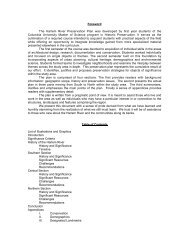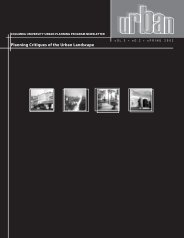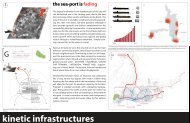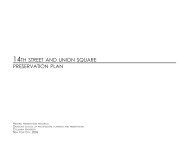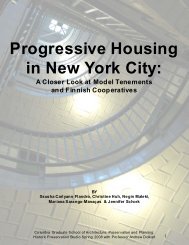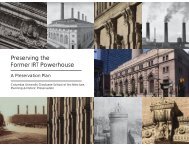The Art of Planning - Columbia University Graduate School of ...
The Art of Planning - Columbia University Graduate School of ...
The Art of Planning - Columbia University Graduate School of ...
Create successful ePaper yourself
Turn your PDF publications into a flip-book with our unique Google optimized e-Paper software.
6<br />
ME AND BLOOMBERG DOWN BY THE SCHOOLYARD<br />
BY Kasey LaFlam<br />
What’s that you say, Mayor Bloomberg? You want every New Yorker to be within a<br />
ten-minute walk <strong>of</strong> a park by 2030? Most would say that it can’t be done unless<br />
the City does something unusual, like, say, unlocking the gates <strong>of</strong> nearly 290 public<br />
school playgrounds across the five boroughs. Well, it just so happens that the Bloomberg<br />
administration plans to do just that. This endeavor does not come without controversy,<br />
however. Who will ultimately be responsible for the maintenance <strong>of</strong> the City’s schoolyards?<br />
Who will determine the rules <strong>of</strong> these new open spaces and, more importantly, who will<br />
enforce them? While this initiative is already underway, questions remain. Where are the<br />
answers? Well, they’re underway too.<br />
<strong>The</strong> City’s initiative to ensure that all New Yorkers have equal access to quality open<br />
space is being coordinated with the Trust for Public Land’s (TPL) Parks for People<br />
program. TPL is a non-pr<strong>of</strong>it organization committed to preserving land to be used for<br />
playgrounds, community gardens, and historic sites. <strong>The</strong> City has committed to match two<br />
dollars to every one dollar that TPL raises for the complete renovation <strong>of</strong> some 25 school<br />
playgrounds. <strong>The</strong> spaces, designed by TPL, include amenities such as basketball courts,<br />
running tracks, green space, safe and healthy playing environments and, best <strong>of</strong> all, public<br />
spaces that communities can use when school is not in session. 1<br />
At the New <strong>School</strong> this September, a panel discussion entitled “Opening the <strong>School</strong>yard<br />
Gates: Reclaiming Urban Community Space,” used Sunset Park in Brooklyn as the poster<br />
child for what a revitalized park could <strong>of</strong>fer to the local school and to the community. Before<br />
the City released PlaNYC, a group <strong>of</strong> concerned staff members at the Center for Family<br />
Life in Sunset Park, a community organization affiliated with PS 503/506 (formerly known<br />
as PS 314), had recognized the need to provide the community and its at-risk youth with<br />
safe public space. 2 Reclaiming park space riddled with gang activity after dark was a<br />
major challenge for the Sunset Park community. In 1999, with the assistance <strong>of</strong> a grant,<br />
the Center for Family Life was able to purchase new basketball hoops, obtain computer<br />
and video equipment for evening classes, and hire evening staff between the hours <strong>of</strong> 4pm<br />
and 8pm to monitor activity in the park and run family-focused programs. As a result <strong>of</strong> this<br />
initiative, today the park is filled with community members <strong>of</strong> all ages at all hours. <strong>The</strong> park<br />
has different amenities and separate space for different types <strong>of</strong> park-goers, but these<br />
separate spaces have been designed to promote interconnectivity, and bring together<br />
young and old in a shared reclamation <strong>of</strong> precious and scarce urban open space.<br />
<strong>The</strong> City and its communities must overcome many potential pitfalls when retr<strong>of</strong>itting urban<br />
open space. <strong>The</strong>re is still much discussion about who will be responsible for maintaining<br />
and monitoring new community open space. Should it be the responsibility <strong>of</strong> the park<br />
service or the school custodial staff to clean up the empty c<strong>of</strong>fee cups, broken beer bottles,<br />
and cigarette butts that could litter schoolyards as a result <strong>of</strong> increased public access?<br />
Some would argue that if the parks had supervision, those items would not be left behind<br />
in the first place. But who or what organization should be responsible for monitoring these<br />
newly opened spaces, and for how much time each day? Will the park be open through<br />
the night, or will supervisors lock the gates at 8pm when they leave? Will certain users<br />
be prevented from using the open space at night? <strong>The</strong>se are just some <strong>of</strong> the questions<br />
that many neighborhoods will have to answer if and when schools open their gates to the<br />
public.<br />
Despite these important logistical questions, the potential benefits <strong>of</strong> opening these<br />
290 schoolyards after school are immeasurable. Providing children and their families<br />
with a place to play helps enhance the quality <strong>of</strong> life for everyone in the community. And<br />
converting schoolyards into public park space is an excellent use <strong>of</strong> existing resources.<br />
With the right financing, the sharing <strong>of</strong> space (school by day, park by night) could potentially<br />
improve the schoolyards, leaving them better <strong>of</strong>f than they were before public evening<br />
use. And we’re not just talking benches and basketball hoops; many <strong>of</strong> these open space<br />
renovations contain interesting architectural elements, intricate landscape designs, and<br />
vibrantly colored playground equipment. This creates an inviting and habitable atmosphere<br />
for all members <strong>of</strong> the community. Surely, this is an endeavor well worth the time and<br />
consideration <strong>of</strong> all members <strong>of</strong> the planning community.<br />
REFERENCES<br />
1<br />
www.tpl.org/nyc.<br />
2<br />
“A <strong>School</strong>yard in Brooklyn,” Center for New York City Affairs, <strong>The</strong> New <strong>School</strong>, June 2007.<br />
URBAN



